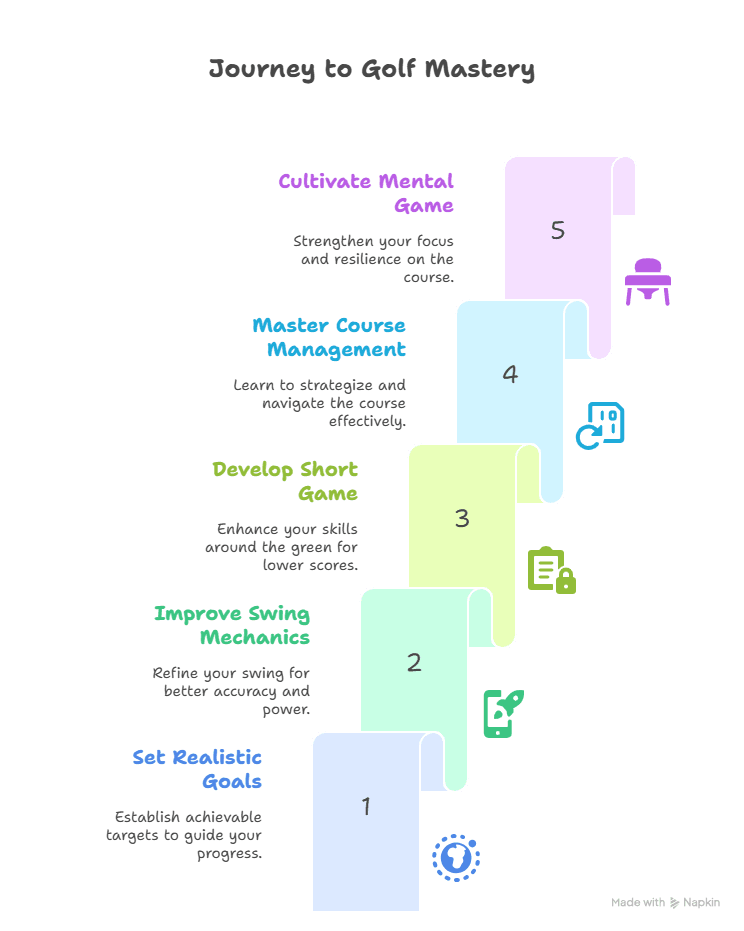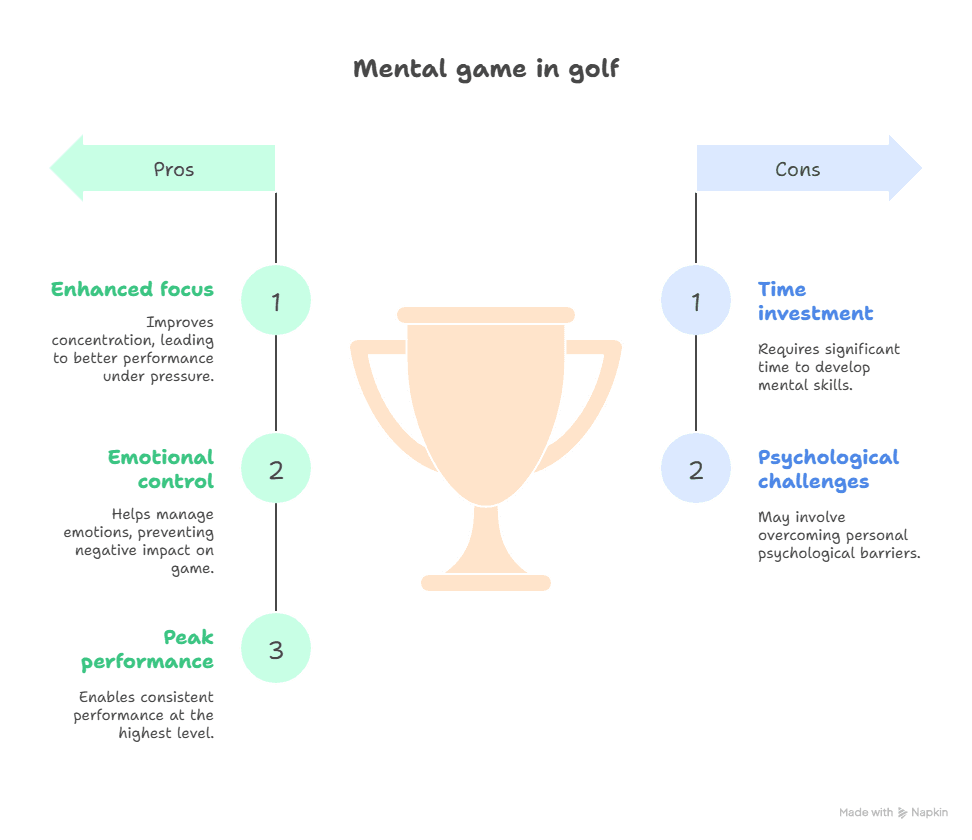Top Takeaways and Key Concepts
→ Set clear, realistic goals that focus on specific improvements like lowering scores or mastering key shots.
→ Create a structured practice plan that balances driving, chipping, and putting for consistent skill growth.
→ Seek feedback regularly from coaches or peers to uncover strengths and fix weaknesses effectively.
→ Use mindfulness techniques such as breathing and visualization to stay calm and focused under pressure.
→ Celebrate small victories to stay motivated and enjoy steady progress toward your golf goals.
Summary of This Article
This article guides golfers to success through goal setting, focused practice, and mindfulness. It emphasizes learning from feedback, balancing all aspects of training, and maintaining a positive mindset. Readers discover how small victories and steady improvement lead to long-term confidence, consistency, and greater enjoyment of the game—on and off the course.
Video Summary
Please Note: This post may contain affiliate links. If you click one of them, we may receive a commission at no extra cost to you. As an Amazon Associate, I earn from qualifying purchases.
Golf can be a tricky game, right? One minute you’re nailing drives down the fairway, and the next, you’re wondering how that ball ended up in the neighbor’s backyard. But if you're serious about improving your game and achieving your golf goals, fear not!

With a little planning and some good old-fashioned practice, you can transform from an occasional duffer into a confident player who knows their way around the course. Let’s dive into some key areas that will help you on this journey!
Set Clear and Realistic Goals

“Success depends upon the preparation beforehand. The more you prepare, the luckier you appear on the golf course.” – Gary Player
What do you want to do first? You might think this is a question for a life coach or someone selling scented candles at a farmer's market, but trust me, it's really important for every golfer to create clear and doable goals. Instead of saying something generic like “I want to get better,” consider breaking it down into smaller parts. You could want to cut your score by five strokes or finally get the hang of that annoying 10-foot putt.
This is when things start to get interesting. I had stars in my eyes and aspirations of glory dancing in my head when I made my own golf goals last year. I mean, who wouldn't want to be the next Tiger Woods? Imagine walking confidently onto the green on Sunday in a smart red polo shirt, with fans cheering as you sink the winning putt. This sounds like something that would happen in a sports movie, doesn't it? But then reality hit me harder than a car that went off the road and into the woods.

When I sat down to write down my goals for the season, I noticed something important: I was trying to reach them too quickly. Of course, it's great to dream big! But if your talents are more “lost ball” than “long drive,” it might be time to lower those high hopes. You need to build up your endurance first, like trying to run a marathon without ever having jogged around the block.
Instead of focusing on becoming a golfing legend overnight (which can get you angry faster than you can say “fore!”), why not set little goals that you can truly reach? For example, if you keep going off course and into the rough or sand traps (believe me, I've been there), you might want to focus on hitting more greens in regulation before you start thinking about birdies and eagles. This method helps you construct a strong base on which you can improve your talents over time.
When you think about it, modest victories lead to bigger ones! Every time you hit your target or score par instead of double bogey, it feels like winning an Olympic gold medal in your own golf games. These small successes will give you more confidence and keep you going on your road. Also, they remind you that becoming better isn't always about big changes; it's often about those small moments when everything comes together.
Did you know that in 1970, a golfer named John “the Hound” Houghton set a goal to play every golf course in the world? He ended up playing over 2,000 courses but still couldn't find one where he could avoid hitting into the water. His friends joked that his real goal should have been to master swimming!
Whether it’s mastering that tricky chip shot or finally getting comfortable with your driver again after months of struggle—every bit counts! Before long, those tiny triumphs will accumulate like golf balls in your bag (and trust me; we all have more than we realize). And who knows? One day soon enough, you'll be strutting around the course feeling ready for whatever challenges come your way!
Once you've defined what success looks like for you—whether it's breaking 90 or simply getting out on the course every week—write those goals down! Seriously! You’ll be surprised how much more committed you feel when they’re staring back at you from your fridge door.
Create a Practice Plan

“Golf is a game of inches. The more you practice, the luckier you get.” – Arnold Palmer
Okay! It's time to make a practice plan now that you've set your goals in stone, like a driver holding on to its grip (see what I did there?). This isn't simply a plan; it's your secret weapon for getting through tough periods on the course.
First, choose several days to work on different aspects of your game. You could, for instance, utilize Mondays to practice at the driving range and Wednesdays to work on your putting green. Having a plan is quite helpful, believe me! You might also make these activities more fun by adding some difficulties, by the way. What do you think of the phrase “around the world”? Or hitting objects from different distances as many times as you can? This makes practice more fun and interesting at the same time!
A lot of golfers don't practice their short game enough, when they should be spending half of their time chipping and putting. You go to the driving range and feel like a rock star since your booming drives may impress even the best pros. But when you walk to the green, you realize that your putting skills are more like a baby trying to color between the lines than a pro golfer sinking birdie after birdie.
You know, those big drives are really cool and make for wonderful Instagram posts (who doesn't love a good “look at me crush this ball” video?), but it's frequently the short game that may really make or break your scorecard. If you keep hitting the fairway but then three-putting every hole, all those hard-earned yards can go to waste. Those little strokes build up faster than my efforts to avoid dessert after dinner. I've done everything from putting cookies in my sock drawer to telling myself that fruit is dessert (it's not!).

Now, let's talk about why working on your short game can make a big difference. First of all, chipping and putting make up nearly half of the strokes you take in a round of golf. You read that right! Half of your shots are within a few yards from the hole. So, think about how much better your whole game would be if you spent more time working on these talents. You could save strokes faster than I can say, “Give me another piece of cake!”
If you want to start practicing your short game effectively, try dividing it down into smaller exercises. Try practicing different lays around the green for chipping. This will help you get ready for everything Mother Nature throws at you on any given day. Getting used to different situations, like soft grass or tight lies, will make you feel a lot more confident.
Then there's putting, the hidden hero of golf! To mimic real-course conditions, spend time on varied lengths and grades. I think that setting up targets at different distances helps me focus better and hit the target more accurately. And don't forget to regulate your speed! Have you ever hit the ball just right and it rolled 10 feet past? Yes, we've all been there!
In 2007, a golfer named Ted decided to create the most unconventional practice plan ever: he would only practice his swing while wearing a chicken suit! His rationale? If he could hit the ball in that getup, he'd be ready for anything on the course. While he didn’t become a pro, he did win “Best Dressed” at every charity tournament—proving that sometimes, it’s not just about the practice but also about having fun and standing out!
Remember to keep things fun! Incorporate friendly competitions with friends during practice sessions or set personal challenges for yourself. Maybe aim for making five consecutive putts from three feet away before rewarding yourself with… well, something sweet!
Don’t overlook your short game—it holds more power than most realize in lowering scores and boosting confidence out on the course. By dedicating ample time to chipping and putting instead of just focusing solely on those long drives (as tempting as they may be), you'll see improvements that’ll leave both opponents scratching their heads and desserts looking quite lonely after dinner!
Get Feedback from Others
“To find a man's true character, play golf with him.” – P.G. Wodehouse
This is where it gets real: if you want to make big changes, you need input. Think about it: how many times have we all been happy and unconscious of our defects until someone told us? Friends or teachers can give you helpful feedback that might help you find problems with your swing that you would not have seen otherwise (like that weird chicken dance motion in the middle of your swing).
You could want to record yourself while you practice and share such recordings with other golfers or coaches who are eager to help you out. No judgmental looks, please! Believe me, this might alter everything. Picture putting your phone on a tripod (or holding it up against your golf bag if you're feeling brave) and recording every beautiful swing, awkward posture, or the time you accidently take a divot the size of a small country. At first, it might seem silly, but just wait until you see the video!
I was astonished by what I found when I first started recording my practice sessions. It was like staring into a funhouse mirror as I saw myself swing. Everything looked bigger! It looked like I was trying to swat away an unpleasant fly instead of getting ready for a strong drive when I swung my back. And don't even get me started on my follow-through; it looked like something from a ballet routine that went bad! But here's the kicker: when I showed those movies to friends and teachers, they told me about easy changes that made a big difference.
For example, one buddy said in passing that my grip appeared way too firm. I didn't even know how much pressure I was putting on! I observed an immediate increase in both control and distance after only making a small change: releasing my grip just a little bit. Who would have thought that a small change would work? It was like reaching a hidden level in a video game when everything suddenly makes sense!
Sharing these recordings doesn't have to be hard or scary anymore. Most people are actually thrilled to help each other get better instead of being mean about it. You might make a small group chat with other golfers where everyone shares their footage and provides each other helpful criticism. No negativity is allowed! Think of it as having your own cheerleading squad with you on the course, but without the pom-poms.
Also, getting input from other people might help you see things you might miss when you practice alone. We can get so caught up in our daily lives that we forget important parts of our skill. Having someone else look at you might help you see patterns or habits that need to be changed. For example, I used to sway back and forth during my swing without even realizing it!
In 2010, a golfer named Bob sought feedback on his game from an unusual source: his pet parrot! He would practice his swing while the parrot squawked critiques like “You call that a drive?” and “More follow-through!” Surprisingly, Bob found that the colorful commentary improved his game—though he often wondered if he was training for golf or auditioning for a comedy show. His friends still joke that the parrot should be the one giving lessons!
So why not accept technology and use it to your benefit? Recording yourself is not only enjoyable, but it also gives you useful information about how you do things that might help you get better over time. When you discuss your blunders with friends, they don't seem as scary anymore. At least it's simpler to joke about those “oops” moments together.
Don't be afraid to tap record the next time you practice, in conclusion! Feel free to share those videos with your golfing friends; you never know what tips or methods they might have that could help you play better than you thought possible. With a few small changes based on helpful advise (and maybe less crazy chicken dances), you'll soon be wow everyone—not just with your strong swings, but also with your steady scores!
Joining local golf groups or clubs where members share advice and experiences is also a good idea. Having a built-in support structure just for helping each other reach their golf goals sounds great!
Embrace Mindfulness Techniques
“Golf is a game of the mind, and the mind can be your best friend or your worst enemy.” – Jack Nicklaus
You might think mindfulness is just another buzzword thrown around by yoga enthusiasts sipping green smoothies—but let me tell ya; it's incredibly useful when applied to golf too! Practicing mindfulness techniques helps clear distractions so that when you're ready to take that shot—the world fades away momentarily.

Before you swing, try some breathing exercises. Take a big breath through your nose like you're trying not to smell someone else's lunch nearby (we've all been there). Hold it for a moment, then slowly breathe out through your pursed lips as if you're letting go of the stress you've built up all day. It works like magic!
Also, picture yourself making perfect shots before you actually do them. You might think this is a little strange, like something you'd hear from a yoga teacher or at a meditation retreat, but trust me, this method can really help your game. Imagine this: you're on the tee box, and instead of letting your nerves get the best of you like an uninvited guest, you close your eyes and picture that perfect swing. You can see the ball flying through the air and landing right where you want it to. It feels really amazing, doesn't it?
Did you know that in 2015, a golf course in Scotland hosted a “Mindful Golf Retreat” where participants were encouraged to meditate between holes? One golfer took it a step further and attempted to do yoga on the putting green. Unfortunately, he ended up face-first in a sand trap while trying to master the “downward dog.” The event organizers claimed it was all part of embracing mindfulness—just not the kind that involves avoiding sandy situations!
At first, this visualization exercise made me feel like I was playing pretend. Really! It made me think of when we were kids and used our imaginations to believe we were superheroes protecting the world. But here's the kicker: even though it may sound stupid at first, this mental exercise really works. Studies have found that athletes who use visualization techniques often fare better than those who don't. It's like giving your brain a taste of accomplishment!
Visualization is great because it helps calm those annoying anxieties that come up right before you strike the ball. When you're about to take that important shot, like a long putt or a hard chip, the last thing you want is for your mind to be racing faster than your heart. By picturing yourself succeeding ahead of time, you write a mental script that helps you feel sure and clear about each shot.
This method is interesting since it may be utilized not just when you're practicing, but also right before you go out to play a round of golf. Picture yourself coming up to the first tee and taking a few seconds to picture not just one fantastic shot, but numerous throughout the round. When you play, you'll feel calmer and more focused because you've previously thought about how things will go.
And let's be honest: golf is as much about mental strength as it is about physical skill. Do you remember when everything seemed to be going wrong? It could be windy outside, or there could be a lot of people watching you (no pressure!). In these kinds of scenarios, having imagined successful shots can be like a safety net—you know what you need to do because you've seen it happen in your mind.
To get started with this, try to set aside some time before each round or even during warm-ups at the driving range. Take a minute or two to sit quietly and visualize yourself going through each part of your swing. Think about how it feels physically and emotionally when everything goes right. You may even see specific situations where problems come up, like an unanticipated water hazard, and how easily you'll get through them.
It could feel unusual to add visualization to your daily life at first, but it worked for me! But after I added it to my pre-game routine, I saw big gains in both my performance and my pleasure of the game as a whole. So why not give it a try? I'm all for letting my inner dreamer out if it helps me play better and maybe lose fewer balls on the course.
Celebrate Your Progress
“I don't care if I fall as long as someone picks up my clubs.” – John Daly
Lastly—and perhaps most importantly—don’t forget to celebrate every little victory along the way! Achieving golf goals isn’t just about crossing finish lines; it's also about enjoying each step taken toward improvement.
Didn’t three-putt once today? High-five yourself! Managed not lose any balls in water hazards this round? Treat yourself with ice cream afterward (trust me; calories don’t count after great rounds!). Recognizing progress keeps motivation alive even during tough stretches where scores seem stagnant.
So go ahead—embrace every triumph big or small because they ultimately contribute toward becoming the golfer you've always wanted to be!
Featured Snippet: To reach your golf goals, start with clear objectives, structured practice, and mindful focus. Prioritize short-game improvement, seek feedback from others, and celebrate steady progress. With consistent effort and patience, any golfer can build confidence, sharpen performance, and enjoy the game more fully both mentally and physically.
Frequently Asked Questions
How can I set realistic golf goals?
Start with measurable targets like reducing your score by a few strokes or improving putting accuracy. Break big goals into smaller, achievable steps that build confidence and consistency.
What’s the best way to structure a golf practice plan?
Divide your sessions between driving, chipping, and putting. Focus at least half your time on the short game to see faster overall improvement.
How often should I practice golf to see progress?
Practicing two to three times a week with focused drills can yield steady improvement. Consistency matters more than long, infrequent sessions.
Why is feedback important for golfers?
Feedback from coaches or friends helps identify unnoticed swing issues and bad habits. Video analysis also allows you to see and correct form errors more effectively.
Can mindfulness really improve my golf game?
Yes! Techniques like deep breathing and visualization reduce stress, increase focus, and enhance mental clarity before each shot or round.
What’s the best way to stay motivated while learning golf?
Celebrate small wins—like improved accuracy or fewer missed putts—to maintain motivation. Recognizing progress keeps your enthusiasm alive through challenges.
How can I enjoy golf more while still improving?
Keep a positive mindset, practice regularly, and play with friends who share your goals. Balancing focus and fun makes long-term growth sustainable and enjoyable.
Suggested External Resources:
The Ultimate Guide to Golf Practice
https://www.golfdigest.com/story/the-ultimate-guide-to-golf-practice
Mindfulness Techniques for Better Golf Performance
https://www.golf.com/instruction/2020/05/12/mindfulness-techniques-golf-performance/
How To Set SMART Goals in Golf
https://www.golfchannel.com/news/how-set-smart-goals-golf

Kevin Collier is an avid golfer and contributing author at AIGolfTips.com, where he shares his passion for the game through expert tips, techniques, and gear reviews. With years of experience on the course, Kevin offers valuable insights for golfers of all skill levels, helping them improve their game and maximize their potential. Whether discussing swing mechanics or the latest in golf technology, Kevin's engaging approach aims to inspire and educate fellow golf enthusiasts to elevate their performance and enjoy every moment on the green.





